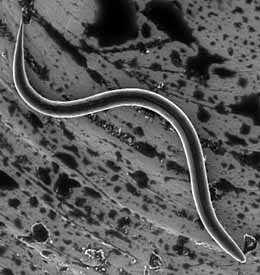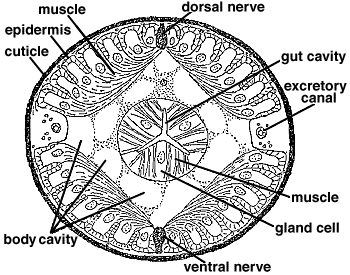Roundworms (nematodes) are bilaterally symmetrical, worm-like organisms that are surrounded by a strong, flexible noncellular layer called a cuticle. Their body plan is simple. The cuticle is secreted by and covers a layer of epidermal cells. Near the body wall but under the epidermal cells are muscle cells; they run in the longitudinal direction only. A true coelom is lacking, instead, nematodes have a "pseudocoel" formed directly from the cavity of the blastula (rather than as a result of the division or folding of mesoderm). The cavity of the pseudocoel is small, being mostly filled with an intestine and oviducts or testes. A simple nervous system consists of a ring of nervous tissue around the pharynx that gives rise to dorsal and ventral nerve cords running the length of the body.
Nematodes move by contraction of the longitudinal muscles. Because their internal pressure is high, this causes the body to flex rather than flatten, and the animal moves by thrashing back and forth. No cilia or flagellae are present.
Some nematodes have specialized cells that excrete nitrogenous wastes; in others, canals or canals plus these specialized cells are present. Nematodes do not have flame cells.
Most nematodes are dioecious. Fertilization takes place when males use special copulatory spines to open the females' reproductive tracts and inject sperm into them. The sperm are unique in that they lack flagellae and move by pseudopodia, like amoebas. Development of fertilized eggs is usually direct.
Nematodes are almost unbelievably abundant. One study reported around 90,000 individual nematodes in a single rotting apple. Another reported 236 species living in a few cubic centimeters of mud. The number of described species is around 12,000, but too little attention has been paid to these animals and the true number may be closer to 500,000. Some species are generalists, occuring across wide areas and in many habitats; others are much more specialized. Nematodes have colonized nearly every conceivable habitat on earth, including such unlikely places as under beer coasters in Germany (Panagrellus redivivus). Some nematodes are also extreme habitat specialists, living, for example, only in the placentas of sperm whales (Placentonema gigantissima), or the right kidneys of minks (Dioctophyme renale)
Many nematodes are free living and play critical ecological roles as decomposers and predators on microorganisms. But nematodes also include parasitic species, a number of which affect humans directly or indirectly through their domestic animals. These include the common roundworms, which probably infest more than half the world's humans; hookworms; trichina, the worms that cause trichinosis; pinworms, another extremely common parasite, even in the United States, which can be transmitted from human to human by eggs floating in household dust; and filarial worms, primarily tropical parasites that cause diseases such as filariasis (elephantiasis) and onchocerciasis (river blindness).
 |  |
Roundworms : The image at left shows a living microscopic roundworm as viewed with an Environmental SEM. The worm is approximately one millimeter long. At right, a diagrammatic view of the internal anatomy of a roundworm, showing the simplicity of its organization. See text below for discussion. (Click on either of the pictures above for a larger image).
The body of a nematode is long and narrow, resembling a tiny thread in many cases, and this is the origin of the group's name. The word "nematode" comes from a Greek word nema that means "thread". The epidermis(skin) of a nematode is highly unusual; it is not composed of cells like other animals, but instead is a mass of cellular material and nuclei without separate membranes. This epidermis secretes a thick outer cuticle which is both tough and flexible. The cuticle is a feature shared with arthropods and other ecdysozoans. As in those other groups, the cuticle is periodically shed during the life of a nematode as it grows, usually four times before reaching the adult stage. The cuticle is the closest thing a roundworm has to a skeleton, and in fact the worm uses its cuticle as a support and leverage point for movement. Long muscles lie just underneath the epidermis. These muscles are all aligned longitudinally along the inside of the body, so the nematode can only bend its body from side to side, not crawl or lift itself. A free-swimming roundworm thus looks rather like it is thrashing about aimlessly.
Life Cycle
Steinernematids and heterorhabditids have similar life histories. The non-feeding, developmentally arrested infective juvenile seeks out insect hosts and initiates infections. When a host has been located, the nematodes penetrate into the insect body cavity, usually via natural body openings (mouth, anus, spiracles) or areas of thin cuticle. Once in the body cavity, a symbiotic bacterium (Xenorhabdusfor steinernematids, Photorhabdus for heterorhabditids) is released from the nematode gut, which multiplies rapidly and causes rapid insect death. The nematodes feed upon the bacteria and liquefying host, and mature into adults. Steinernematid infective juveniles may become males or females, where as heterorhabditids develop into self-fertilizing hermaphrodites although subsequent generations within a host produce males and females as well.

The life cycle is completed in a few days, and hundreds of thousands of new infective juveniles emerge in search of fresh hosts. Thus, entomopathogenic nematodes are a nematode-bacterium complex. The nematode may appear as little more than a biological syringe for its bacterial partner, yet the relationship between these organisms is one of classic mutualism. Nematode growth and reproduction depend upon conditions established in the host cadaver by the bacterium. The bacterium further contributes anti-immune proteins to assist the nematode in overcoming host defenses, and anti-microbials that suppress colonization of the cadaver by competing secondary invaders. Conversely, the bacterium lacks invasive powers and is dependent upon the nematode to locate and penetrate suitable hosts.
Shailesh kr shukla
directoratace@gmail.com
No comments:
Post a Comment